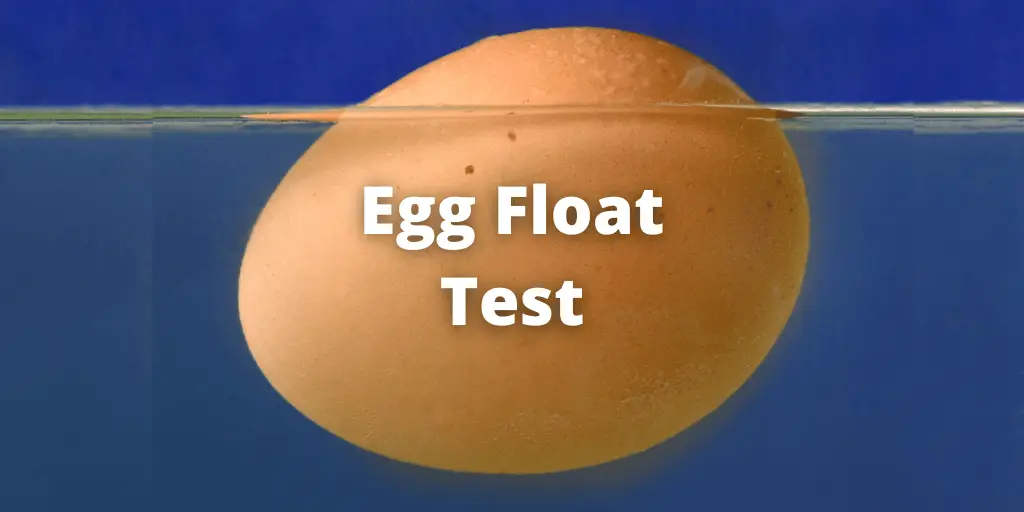The egg float test is a simple method to know if the egg is fresh or old. It’s a fast and easy method to check at home if the egg is fresh or rotten.
Do you want to know about the steps in the egg-float test?
In this guide, you will learn all about the egg-floating test.
We have included the steps to do the test, myths, reality, factors affecting and understanding the results of the egg float test.
So, start the guide to understand the different egg-freshness test methods.
Introduction to the Egg Float Test
The egg float test is a popular way to check egg freshness. It includes watching an egg float or sink in a dish of water. Fresh eggs sink, whereas old ones float.
This egg-floating test is popular because it’s simple and requires no equipment. However, many egg-floating test myths can produce inaccurate results.
How Does the Egg Float Test Work?
The egg float test depends on buoyancy. Eggshells are porous, which allows air to pass.
Freshly laid eggs have little air inside. The egg becomes less dense as the air cell inside the shell grows larger with time.
The decrease in density impacts the buoyancy of eggs in water. Buoyancy occurs in water when an egg displaces water.
The buoyant force equals the egg’s water displacement. Eggs sink if their density of egg exceeds the water’s density.
Less dense eggs float more. Fresh eggs are denser and sink because their air cells are smaller. Old eggs float more because their air cells are bigger and less dense.
Egg Float Test Myth vs. Reality
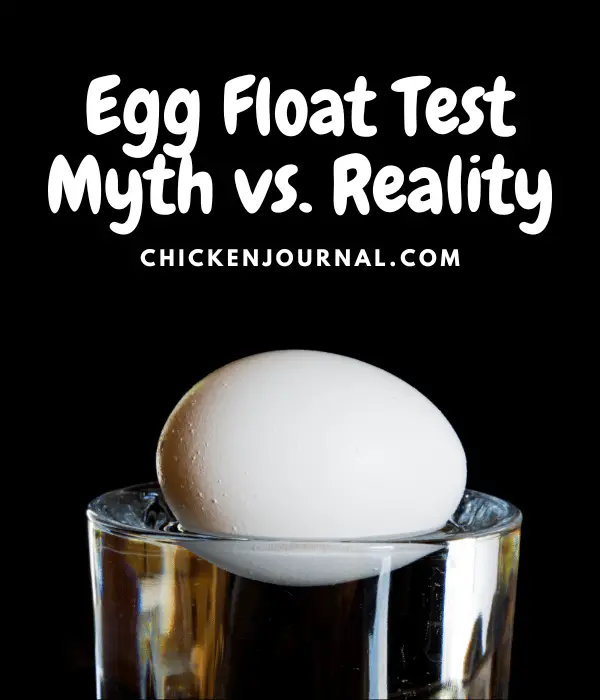
The egg float test is a common egg freshness test. Several inaccuracies about this test can confuse you. Discover the truth behind five common myths and the reality of the egg-floating test.
Myth 1: Egg quality is determined by the egg float test.
Reality: The egg float test only measures freshness, not quality. Freshness is how long an egg has been stored, whereas quality includes taste, texture, and nutrients.
Myth 2: Floating eggs are bad.
Reality: Floating eggs are less fresh than sinking ones, but they’re still edible. Floating eggs are edible but not ideal for freshness-sensitive recipes.
Myth 3: All eggs should sink in water.
Reality: Eggshells contain small air cells. These air cells increase with maturity, making eggs buoyant and maybe float. Due to air cell size differences, fresh eggs might float. Thus, not all sinking eggs are fresh.
Myth 4: The egg float test works on all eggs.
Reality: Since chicken eggs are widely consumed and have clear freshness standards, the egg float test is best. Eggs like duck or quail may have varied densities and air cell diameters, making the test less accurate.
Myth 5: Water temperature impacts test results.
Reality: Egg float test accuracy is unaffected by water temperature. Egg freshness doesn’t depend on cold or warm water. Shell buoyancy depends only on air cell size.
In conclusion, the egg float test can evaluate egg freshness, but it’s crucial to distinguish fact from imagination. Remember that the test only measures freshness, not quality. While a floating egg may be less fresh, it’s not always awful. Due to air cell size differences, fresh eggs may float or sink while being less fresh. The test is most accurate for chicken eggs and is unaffected by water temperature.
Factors That Affect Egg Freshness
The egg float test result is not only determined by the age of the egg but also by many other factors. Here are some of them:
Egg Age
As mentioned earlier, the age of an egg affects its buoyancy in water. The older the egg, the larger the air cell, and the greater the likelihood that it will float.
Temperature
Egg temperature also impacts the size of the air cell. If the eggs are stored at a warm temperature, the air cells will grow faster, causing the eggs to age more quickly.
Eggs should be stored at a consistent temperature of around 40 °F. Higher temperatures can cause the eggs to spoil faster.
Humidity
Humidity can affect the porosity of the eggshell, which in turn affects the air cell size. Therefore, eggs stored in a humid environment will have a larger air cell and may float even if they are relatively fresh.
Egg Size
The size of the egg can also impact the egg float test result. More giant eggs have larger air cells, so they may float even if they are fresh.
Egg Handling
You should handle eggs carefully to avoid cracking or breaking the shell. Cracked eggs may allow bacteria to enter the egg, even if fresh.
Understanding the Egg Float or Sink Test Results
Now that we understand the science behind the egg float test let’s look at how to interpret the results.
You’ll observe one of two things when performing the egg float test.
- The egg sinks to the bottom and lies flat on its side: It indicates the egg is fresh and safe to eat.
- The egg floats to the surface: This indicates that the egg is no longer fresh and should be discarded.
Egg Float Test Chart and What It Means?
Here’s a handy chart that summarizes the egg float test results:
| Egg Position | Egg Freshness |
| Sinks to the bottom and lies flat on its side | Fresh |
| Sinks to the bottom but stands upright or tilts slightly | Less fresh but still good to eat |
| Floats to the surface | No longer fresh, it should be discarded |
The egg floating test chart shows the relationship between the egg position, air cell size, egg age, and freshness. Fresh eggs sink to the bottom of the water and have a small air cell.
An egg that tilts up but doesn’t float is less fresh but safe to eat. An egg that floats to the top of the water surface is old and should be discarded.
Note: It’s important to note that even if the egg floats, it doesn’t necessarily mean it’s bad. You can still use the egg for cooking or baking, but it’s not recommended to eat it raw.
Egg Float Test Pictures and Examples
Here are some pictures and examples of the egg float test results:
Fresh Egg
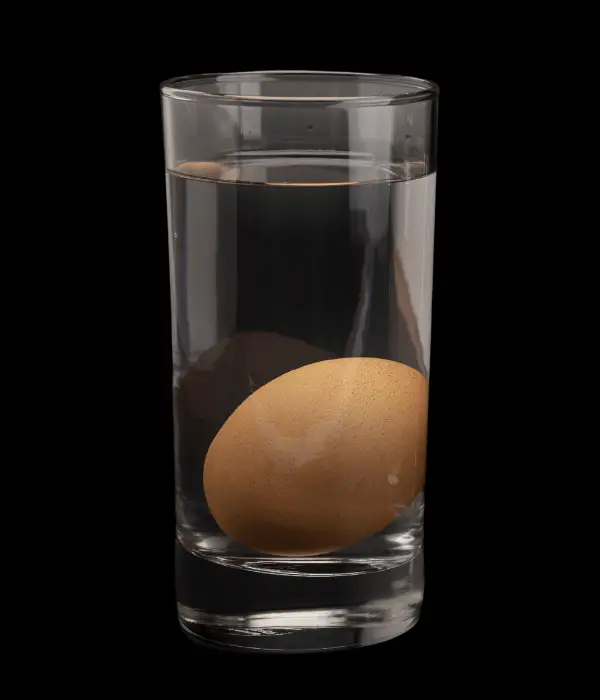
A fresh egg will sink to the bottom and lie horizontally.
Less Fresh Egg
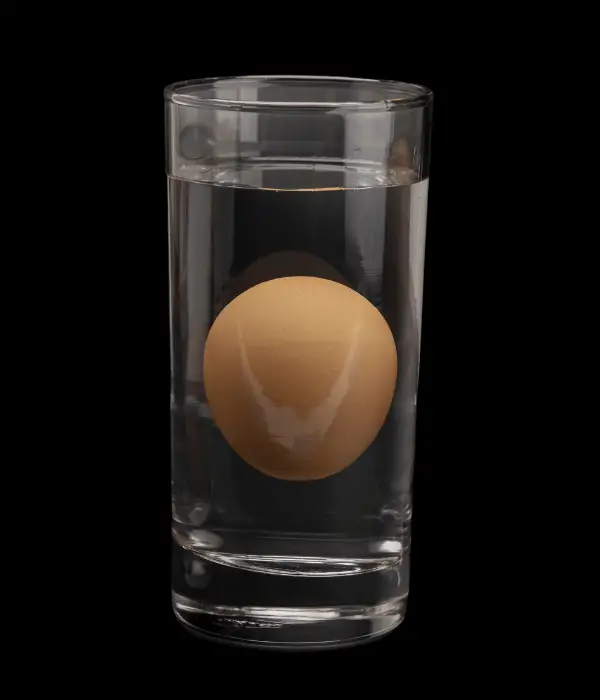
A less fresh egg will tilt up but still touch the bottom of the bowl. This means the egg is two to three weeks old.
Old Egg
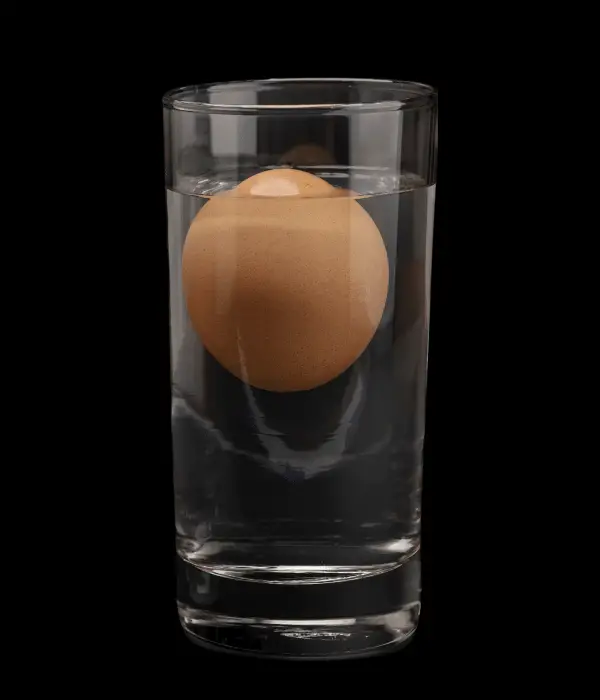
An old egg can float to the top and have a large air cell. This means it is a two to three months old egg.
Egg Float Test Science Experiment with Its Hypothesis
The Egg Float Test is a basic science experiment that examines egg freshness.
The hypothesis for this experiment is that fresh eggs sink and older eggs float.
The Egg Float Test requires these items:
- A water-holding bowl.
- Fresh eggs.
- Tap water.
Step-by-step instructions for the experiment:
- Put enough tap water in the bowl to submerge an egg completely.
- Gently place one egg in water and watch it.
- Fresh eggs sink to the bottom and lie flat.
- An upright egg at the bottom of the container is still fresh but not as fresh as a flat egg.
- Discard the egg if it floats or stands upright on one end near the surface.
Understanding egg air gap development is the science underlying this experiment. As an egg ages, its permeable shell evaporates moisture, expanding its air pocket.
This increase in air cell size makes older eggs less dense than fresh ones, allowing them to float.
This easy experiment lets you rapidly tell if an egg is fresh or old without cracking it.
Although this test indicates freshness, it does not guarantee safety for eating.
Use proper storage and check for spoilage before eating eggs to maintain food safety.
Other Methods to Test Egg Freshness
There are several other methods to test egg freshness:
Candling: The process of candling, which involves holding the egg against a strong light, is a common procedure. One can inspect for blood spots or shell breaks, which indicate a rotten egg.
Sniff test: You can also sniff a spoiled egg for unpleasant odors. Due to protein breakdown, ruined eggs smell sulfuric, while fresh eggs smell neutral.
Plate test: The plate test is another simple yet efficient egg freshness test. Place an egg on a flat surface and gradually spin it to study its behavior. A fresh egg spins smoothly and fast. It may be older and less fresh if it wobbles or spins slowly.
Visual test: Egg freshness is also determined visually. High, rounded yolks and clear, crisp whites characterize fresh eggs. Older eggs have watery whites and flatter, expanded yolks.
Checking carton expiry date: Finally, verifying the carton date can indicate egg freshness. Most cartons’ “sell-by” or “expiration” date specifies when the eggs were packed or should be eaten. If refrigerated properly, eggs can be eaten 4-5 weeks after their pack date.
FAQs on Egg Float Test
Here are a few common FAQs about the Egg Float Test:
Is the egg float test accurate?
The Egg Float Test is a common egg freshness test. This test can indicate egg freshness, although it may not always be reliable. This test should be a guideline rather than the sole decider of an egg’s freshness because temperature and storage circumstances can also alter buoyancy.
Can you eat a pink yolk egg?
Pink-yolk eggs are edible. Egg yolk color depends on the chicken’s diet. The yolk can turn pink if a hen eats pigments from plants or insects. Despite its appearance, a pink yolk does not signify a damaged egg.
A pink yolk may indicate blood or germs. Pink-yolked eggs aren’t advised. Sometimes pink or pearly egg white (albumen) suggests Pseudomonas-caused spoiling, per the USDA.
Can you eat a red blood spot yolk egg?
You can eat red blood spot yolk eggs. In some hens, a tiny blood vessel in their reproductive system ruptures during egg-laying, causing a red yolk splotch. This is normal and does not influence egg safety or taste. However, others may remove the blood spot before eating the egg for aesthetics.
Can you eat a black color inside egg?
An egg with black insides can be eaten. A small piece of tissue that broke off the hen’s reproductive system and became trapped in the egg causes this “meat spot.” It may look disgusting, but it is safe and does not affect egg taste or quality. Some people remove the black spot before eating for appearance.
What happens if you wash eggs?
Cleaning eggs removes the “bloom.” This bloom prevents bacteria from entering eggs and extends their shelf life. Without this protective covering, eggs may decay faster and get contaminated. It is advisable to wash eggs shortly before use rather than earlier.
What happens if you eat an old egg?
Old eggs may taste bad and cause food sickness. The shell coating on eggs deteriorates with age, allowing bacteria to enter. Old eggs can contain Salmonella, which can cause nausea, vomiting, and diarrhea. To keep eggs fresh and safe, check the expiration date and store them carefully.
What should you do if you accidentally eat an expired egg?
If you accidentally consumed an expired egg, watch for food poisoning symptoms and get medical treatment. Drinking water and resting helps your body recover. To avoid cross-contamination, discard expired eggs and carefully clean any surfaces or utensils that come into contact with them.
How long do egg whites last?
Egg whites can last four days in an airtight container in the fridge. Before eating, look for spoiling symptoms like a bad smell or strange texture. If you’re unsure about the egg whites’ freshness, discard them to avoid health dangers.
Conclusion: Should You Rely on the Egg Float Test?
Egg float tests are popular for detecting freshness but should not be used alone.
A floating egg usually means it’s expired, but other factors must be considered.
Older but edible eggs may sink or stand upright in water due to air cell size changes.
Thus, the egg float test should be combined with other signs like the egg’s odor, look, and purchase date.
Considering these factors, you can choose egg freshness and safety.
